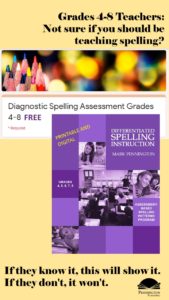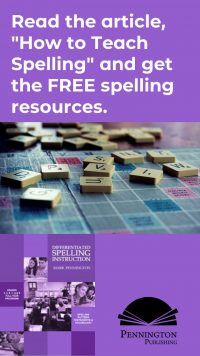Should Grades 4-8 Teachers Teach Spelling?
It depends. The real question is “Do your students (or some of your students) need to improve their spelling?”
The only way to find out is through assessment. The FREE Diagnostic Spelling Assessment has been designed for grades 4, 5, 6, 7, and 8. It is not a random sample spelling inventory. You could give a short inventory, which would hint at problem areas or determine a student’s spelling stage, but you would have to do further assessment to specify the specific unknown spelling patterns to remediate. But the Diagnostic Spelling Assessment does it all in one assessment. The results will indicate problem areas and specific, teachable deficits. Teachers get the data they need to minimize remedial instruction to individual needs.
Assessment Design
The 102 item assessment includes the most common previous grade-level spelling patterns.
- Grade 4: K-3 spelling patterns (#s 1-64)
- Grade 5: K-4 spelling patterns (#s 1-79)
- Grade 6: K-5 spelling patterns (#s 1-89)
- Grade 7: K-6 spelling patterns(#s 1-98)
- Grade 8: K-7 spelling patterns (#s 1-102)
The test items are grouped by spelling patterns e.g., the four long /i/ spellings, to make posttest analysis simple. All spelling words are multi-syllabic to prevent students from identifying the words by “sight spellings” and to require recognition of the sound-spelling patterns within the context of syllables.
Assessment Formats
Choose the Diagnostic Spelling Assessment format which best suits your needs:
1. Paper Only: Teacher dictates the number of test items assigned to the grade levels, following the written administrative protocol. Students take the test on binder paper. Teacher corrects assessments according to directions and records spelling deficits on the Spelling Patterns Assessment Mastery Matrix.
Resources: Diagnostic Spelling Assessment teacher administration form; Spelling Patterns Assessment Mastery Matrix.
2. Audio and Paper: Teacher plays the 22:32 “slow speed” Diagnostic Spelling Assessment audio file for grades 4, 5, and 6 students or the 17:26 “fast speed” Diagnostic Spelling Assessment audio file for grades 7 and 8 students. The audio file includes all administrative directions. Students take the test on binder paper. Teacher corrects assessments according to directions and records spelling deficits on the Spelling Patterns Assessment Mastery Matrix.
Resources: Diagnostic Spelling Assessment 22:38 audio file; Diagnostic Spelling Assessment 17:26 audio file; Spelling Patterns Assessment Matrix.
3. Google Forms: Teacher shares either the Diagnostic Spelling Assessment Google Form with the 22:32 “slow speed” for grades 4, 5, and 6 students or the form with the “fast speed” for grades 7 and 8 students. Note that incorrect spellings with be accompanied by the Google red squiggly line indicating a spelling error. Students may be tempted to right click the word and select the correct spelling; however, if the teacher tells the students the purpose of the test and directs them not to self-correct, students will generally follow instructions. Telling students that they will receive the same amount of credit whether the spelling is accurate or not, and using the “fast speed” audio also helps students avoid the temptation of cheating. Teacher uploads the students’ Google Forms into the Spelling Patterns Assessment Mastery Matrix Google Sheets.
Resources: Diagnostic Spelling Assessment Google Forms with the 22:32 “slow speed” audio file for grades 4, 5, and 6 students or the the 17:26 “fast speed” audio file for grades 7 and 8 students; Spelling Patterns Assessment Mastery Matrix Google Sheets.
If you’ve made the decision that all or some of your students need spelling instruction, please check out the author’s grades 4, 5, 6, 7, and 8 Differentiated Spelling Instruction. Each program includes grade-level spelling tests and spelling sorts, according to age appropriate spelling patterns and 102 remedial worksheets (each with a formative assessment) to helps students master the spelling deficits indicated by the Diagnostic Spelling Assessment. Efficient and targeted spelling instruction! Plus, the spelling sorts and 102 worksheets have a fillable PDF option. Perfect for distance/virtual learning.
Grammar/Mechanics, Reading, Spelling/Vocabulary, Study Skills






